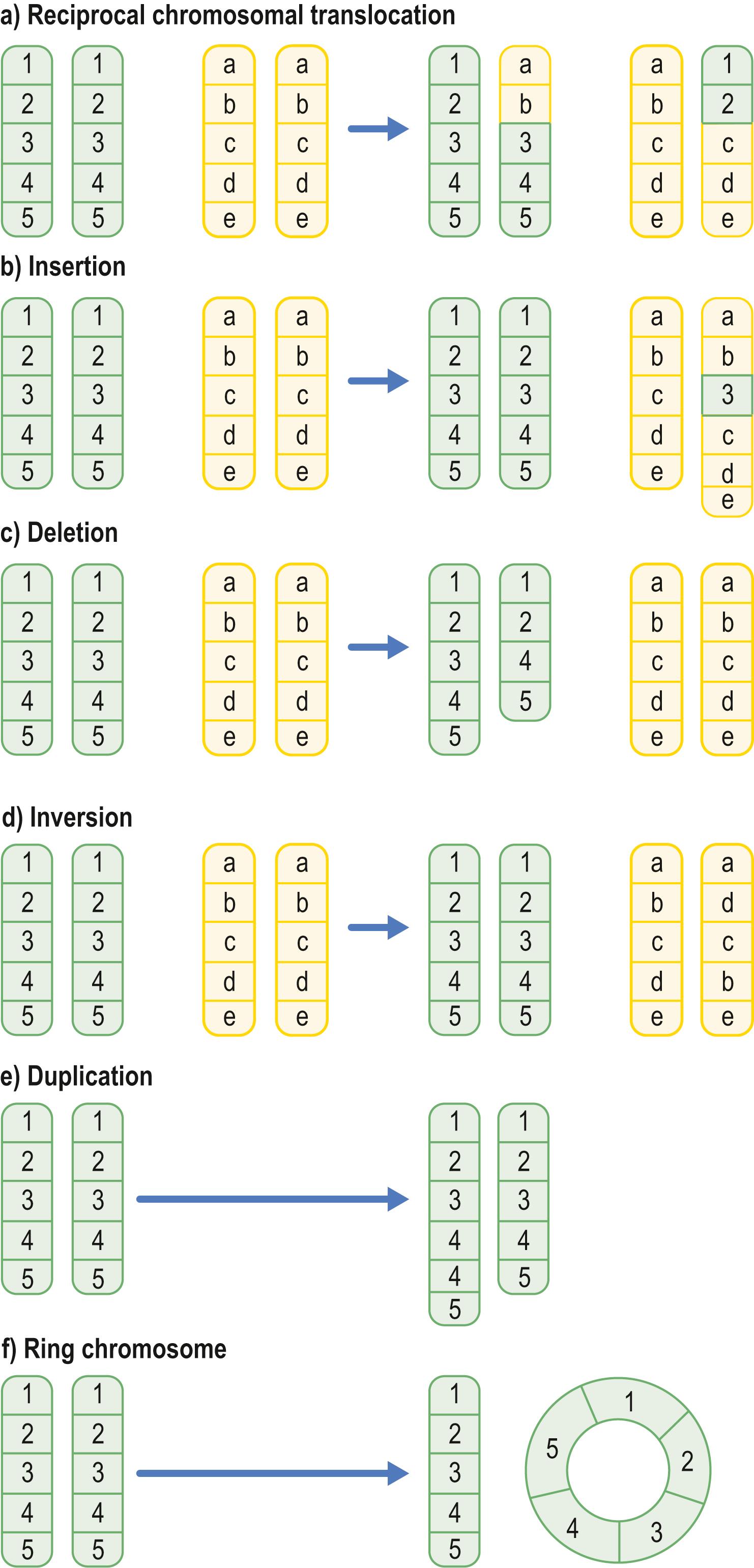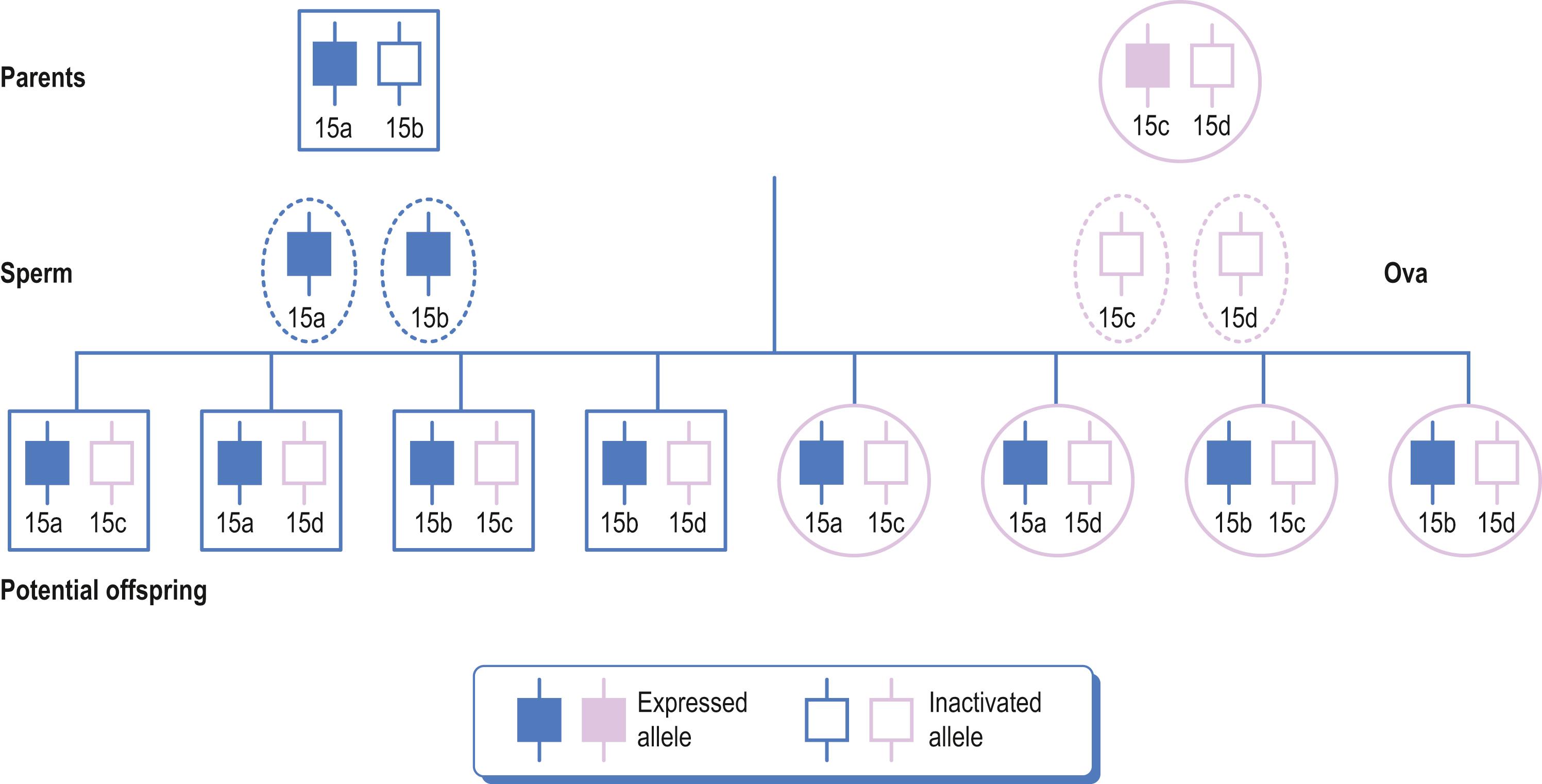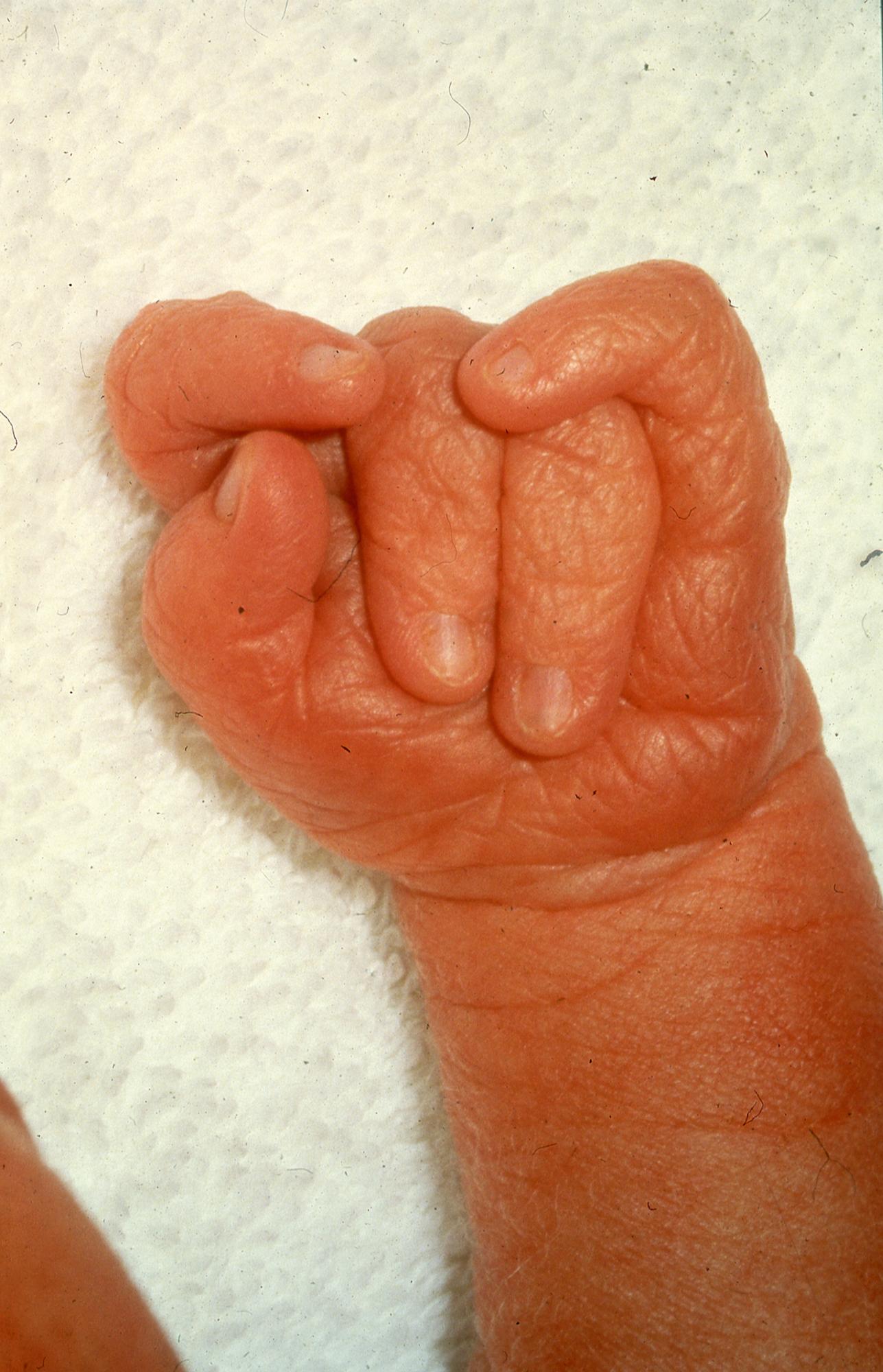Physical Address
304 North Cardinal St.
Dorchester Center, MA 02124
After reading this chapter you should:
be able to explain and provide advice regarding patterns of inheritance
be able to diagnose and manage common genetic and dysmorphological conditions
be able to discuss the role of pre- and postnatal genetic investigations
understand the effects of environmental factors affecting the fetus
There are many conditions seen in paediatric practice that are the result of a genetic mutation, and these range from structural chromosome changes to single nucleotide alterations. These mutations may result in disease and are referred to as pathogenic mutations whilst others, nonpathogenic mutations, are not implicated in disease causation.
Chromosomal abnormalities can be classified as either numerical or structural.
polyploid—additional sets of 23 chromosomes as in triploidy
aneuploidy—presence or absence of one or more chromosome
trisomy—presence of three copies of a chromosome
monosomy—presence of only one member of the chromosome pair
Translocations, most inversions and large (microscopic) deletions, duplications or insertions will be visible on karyotype. Chromosome microarray analysis will detect even small changes in copy number (sub-microscopic deletions and duplications) but will fail to detect other rearrangements, such as translocations and inversions, unless there are associated alterations in copy number of nearby sequences. The recognised types of structural abnormalities ( Figure 5.1 ) include:
translocation—transfer of material from one chromosome to another
balanced translocation—transfer of material between chromosomes but no loss of genetic material
reciprocal translocation—chromosome breaks and exchange of material between chromosomes
Robertsonian translocation—breaks close to the centromere of acrocentric chromosomes and subsequent fusion with another acrocentric chromosome. This leads to the loss of both short arms of the chromosomes involved but without adverse consequences as the missing regions contain no protein-coding genes
insertion—insertion of segment into another position in a chromosome
deletion—loss of part of chromosome
duplication—duplication of part of a chromosome
inversion—section of a chromosome rotated by 180° and reinserted
ring chromosome—chromosome break, with the two ends joining together to form a ring. There is loss of chromosomal material.

loss of part or all of one of the sex chromosomes as in Turners syndrome (45X0)
duplication of one the sex chromosomes as in Klinefelter syndrome (47 XXY)
alterations of one or several contiguous nucleotides, usually within a gene and often within the coding sequence or nearby, so that RNA splicing is affected.
These alterations can be complex. The simplest categories are:
substitutions—replacement of one nucleotide by another
insertions—addition of one or more nucleotide
deletions—loss of one or more nucleotide
The brief description of the nucleotide alteration within the coding sequence of a gene is preceded by ‘c.’ (for coding) and then followed by the associated change in the amino acid sequence of the relevant protein product, itself preceded by ‘p.’ (for protein). Thus, the commonest pathogenic variant in the CFTR gene, causing cystic fibrosis in homozygotes and formerly known as ΔF508, is now presented as: c.1521_1523delCTT; p.Phe508Del.
Such alterations in DNA sequence are now classified by their pathogenicity as definitely benign (class 1), probably benign (class 2), of uncertain significance (class 3), probably pathogenic (class 4) or definitely pathogenic (class 5). There are multiple factors to be taken into account in deciding whether or not a variant is pathogenic. This is complex and involves bioinformatic analysis according to national and international standards and comparisons with international reference databases. It may also require a comparison with test results on parents, siblings and other members of the family.
The disorder is expressed completely in the heterozygote individual, and all offspring of an affected person will have a 50% chance of inheriting the mutation, giving rise to vertical transmission in the pedigree. Variable expression and incomplete or age-dependent penetrance can complicate recognition of autosomal dominant inheritance.
The disorder is expressed in the affected homozygote individuals and may arise de novo or be recognised if
achondroplasia
hereditary elliptocytosis
hereditary spherocytosis
Huntington’s disease
Marfan syndrome
myotonic dystrophy
neurofibromatosis NF1 and NF2
Noonan syndrome
tuberous sclerosis complex
von Willebrand disease
there are affected siblings. When both parents are carriers, each of their offspring has a 25% risk of being homozygous affected and a 50% risk of being a heterozygous carrier.
alpha-1 antitrypsin deficiency
ataxia telangiectasia
beta thalassaemia
cystic fibrosis
Fanconi anaemia
galactosaemia
glycogen storage disorders
homocystinuria
These conditions result from mutations in a gene carried on the X chromosome and therefore males are usually affected as they only have one copy of the gene. Female carriers of X-linked conditions are often unaffected but may show some features of the disease, although usually less severely than an affected male.
Features of this X-linked form of inheritance are:
no male-to-male transmission
all daughters of an affected male will be carriers
half of all daughters of a carrier female will be carriers
X chromosome gene disorders are occasionally separated into X-linked recessive, which tend not to manifest significantly in females, and X-linked dominant in which females are commonly affected. In some of these conditions, males may be so severely affected as to die in utero or in early infancy. The distinction between X-linked recessive and X-linked dominant can help in assessing patterns of inheritance in a family, although the random and variable nature of X chromosome inactivation will often blur the distinction.
Becker muscular dystrophy
Duchenne muscular dystrophy
Glucose-6-phosphate dehydrogenase deficiency
haemophilia A and B
hypohidrotic ectodermal dysplasia
incontinentia pigmenti
Rett syndrome
Wiskott-Aldrich syndrome
Mitochondrial DNA mutations are transmitted by maternal inheritance and are passed down from mother to child but not from father to child. In most people, all mitochondria contain identical copies of the mitochondrial genome (homoplasmy), but in those with mitochondrial disorders there may be a mix of mitochondria with normal and mutated DNA within each cell (heteroplasmy), especially if the mutation would be lethal if it were present in all copies of the genome (that is, if there were homoplasmy for the mutation).
For most autosomal genes, both alleles are expressed in a cell but, for some, only one allele is expressed and the other is switched off. Whether an allele is expressed or repressed is determined by the sex of the parent contributing that gene and the phenomenon is termed imprinting (see Figure 5.2 ). The terms used are:
maternally imprinted gene—the maternally derived allele is inactivated
paternally imprinted gene—the paternally derived allele is inactivated
Prader-Willi syndrome (PWS)—maternally imprinted factors; syndrome arises when the paternal copy is absent (by deletion or maternal disomy) or defective
Angelman syndrome—UBE3A gene, paternally imprinted gene; syndrome arises when the maternal allele is absent or defective
Beckwith-Wiedemann syndrome—there is cluster of growth-regulating genes at distal 11p15 that are subject to a complex pattern of imprinting; the condition can arise when the balance of gene activity is disturbed through a variety of mechanisms, including paternal 11p15 duplication, paternal uniparental disomy, or point mutation in one of the imprinting control regions or in a specific gene
Silver Russell syndrome—has a number of causes including maternal uniparental disomy for chromosome 7 or for 11p15 (the converse of Beckwith-Wiedemann syndrome, above)
pseudohypoparathyroidism type 1a— GNAS1 gene, paternal allele suppressed
pseudopseudohypoparathyroidism— GNAS1 gene, maternal allele suppressed

The number of conditions which have a clear genetic basis is extensive and ever expanding, and a detailed knowledge of the vast majority is beyond the scope of the AKP exam. Clinical features that may suggest an underlying genetic disorder include:
multiple individuals of the same family being affected by the same problem
multiple problems in the same individual including congenital abnormalities, growth problems, neuro-developmental problems and unusual tumours
Certain features on their own may raise suspicion of a genetic condition and examples of such features are:
eyes—unusual shape, different coloured irises
hair—brittle, sparse, white patches
tongue—large or small tongue
teeth—misshapen, extra, primary oligodontia
extremes of stature
digits—webbed
birthmarks that are unusual
There are, however, a core of conditions which may be seen by the paediatric team due to specific abnormalities such as neurodisability, congenital cardiac abnormalities or specific facial or somatic features. Some of these conditions are presented here to illustrate recognised inheritance patterns and some identifiable clinical features and it would be important for candidates to review as many images as possible for each of these recognised diagnoses. This section will show the diagnosis and the associated phenotypic features, but further details about associated clinical problems and their management will be presented in the chapters indicated.
Confirmation of the clinical suspicion through more detailed investigations should be undertaken by clinical genetics teams who will have access to the most appropriate investigations, the required understanding to interpret the results and the appropriate team members to explain the findings and implications to the patient and their family members.
Trisomy 21—most arise through nondisjunction
Common phenotypic features
eyes—up-slanting, epicanthic folds, Brushfield spots, cataracts
midface hypoplasia, small mouth and jaw
brachycephaly
hand abnormalities—single palmar crease, (short broad) hands, clinodactyly
hypotonia and hypermobility
intellectual disability common (usually mild-moderate)
cardiac abnormalities—AVSD most common then VSD then ASD
Antenatal screening is offered to all pregnant women and is outlined in further detail below. Details of management are to be found in Chapter 27 Neurodevelopmental Medicine
Trisomy 13
Common phenotypic features include
cleft lip and palate
polydactyly
eye abnormalities—microphthalmia, anophthalmia, coloboma
cardiac anomalies—VSD, ASD
CNS defects, including holoprosencephaly and meningomyelocoele
death usually within the first 12 months
Trisomy 18
Common phenotypic features include
significant defects in brain development
eye abnormalities—microphthalmia, anophthalmia, coloboma
cardiac anomalies—VSD, ASD
characteristic hand position at birth (see Figure 5.3 )

death usually within the first 12 months, but survival has improved over the past few decades
Become a Clinical Tree membership for Full access and enjoy Unlimited articles
If you are a member. Log in here